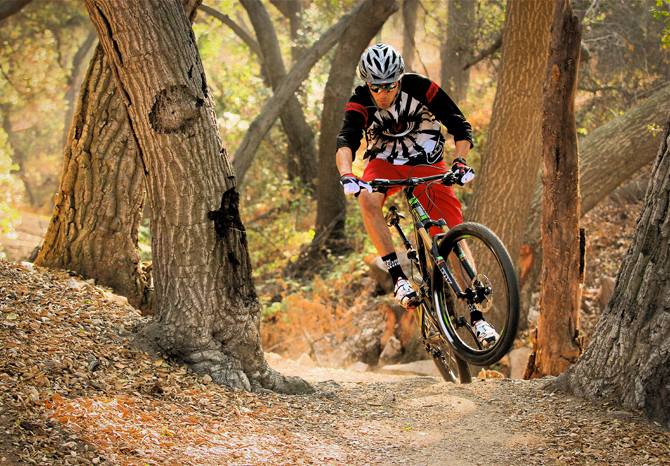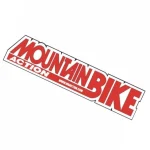Bike Test: Trek Fuel EX 9

When Trek set out to design the new Fuel EX, they up when the wheel moves deep into its travel. We’ve had wanted to set the bar for mountain bike versatility. The bike they came up with pulls from their extensive ride time and research with some of the best riders on the planet. The aluminum-framed version is not their top of the line (the carbon frame gets that title), but the EX9 sports all the high-end technologies.
WHO IS IT MADE FOR?
This bike can work for a huge range of riders, and that’s what being a true trailbike is all about. The Fuel EX9 sports just enough travel to feel aggressive, but not so much that it will hold you back on a long ride or a climb. This bike is all about versatility.

WHAT IS IT MADE FROM?
The Alpha Platinum aluminum frame features just over 5.1 inches of rock-gobbling suspension that uses Trek’s proprietary ABP (Active Braking Pivot) design. This design uses a pivot at the dropout inline with the rear axle and a “floating” shock that attaches to the swingarm to keep the suspension active and neutral during braking and pedaling efforts. The frame also sports a tapered head tube, one-piece magnesium rocker, and integrated chainstay and downtube protection.

WHICH COMPONENTS STAND OUT?
The shock’s DRCV (Dual Rate Control Valve) technology works by using an additional air chamber that’s only opened up when the wheel moves deep into its travel. We’ve had great luck with this shock technology, but always said we’d like to see it in the fork to offer a more balanced feel. This is the first year Trek has done that. That little bit of extra air keeps the suspension from feeling like you’re getting cheated out of the last 20 percent of your travel from the air pressure “ramping up.” Bravo, Trek.
The Bontrager XR3 Team tires are a perfect fit for the EX. They roll fast and hook up very well in a wide variety of conditions. There was a day when Trek bikes were held back by mediocre, house-brand tire choices, but those days are gone.
HOW DOES IT PERFORM?
Setup: Setting up the DRCV should be a hassle, but it’s not. The fork and shock have only one air chamber each to set, and Trek simplifies the process by including clip-on sag meters on both. We set both the fork and shock to 30-percent sag and hit the trails. The beauty of this system is that it can feel both efficient and bottomless with a single setup. The DRCV allows the suspension to move deep into its travel while still delivering a firm pedaling platform. With the Fuel EX, let the fork and shock work their magic.
The rebound damping circuit on the Fuel’s shock is very strong, and we found ourselves running the adjustment near full open. Smaller riders who need lower pressures may have difficulty finding a setting that doesn’t “pack up” on successive hits.
Pedaling: Trek’s DRCV shock and fork (made by Fox) also have Fox’s rider-selected CTD system (Climb, Trail, Descend modes). While the suspension action responds well to all three settings, we found ourselves leaving the suspension in the trail mode most of the time. This bike can do it all when the shock is set right in the middle.

Climbing: The aggressively steep seat tube angle puts the rider right over the pedals, which feels very efficient on long climbs. The plush suspension assists on rough, technical climbs (don’t use the too-firm climb mode in this situation) by allowing the rear wheel to follow the terrain and maintain traction. The 26-inch wheels allow for quick acceleration over obstacles in the climb, and changing lines is almost a subconscious effort.
Cornering: Rumors of the 26-inch-wheeled trailbike being killed off by the 29er and 27-incher are greatly exaggerated. The Fuel EX has something that the big-wheeled bikes can’t exactly match, and that’s maneuverability. The Fuel EX has a snappy and responsive feel in the corners, and the bike loves to be manhandled through switchbacks.
Descending: At the end of a descent, we like to see that we’ve used all the available travel. The DRCV delivers in spades. The front and rear suspension feel exceptionally balanced, allowing you to work the stroke of the shock and fork much more effectively. While the first half of the travel is designed to be efficient, the second half is designed to feel bottomless, and it just plain works. The 5 inches of travel are used so effectively; it feels like the Fuel has even more.
TRICKS, UPGRADES OR TIPS?
The Fuel EX has routing for a RockShox Reverb Stealth seatpost with a remote actuation hose that routes through the frame and connects at the bottom of the seatpost rather than at the head. The EX9 doesn’t use that routing and instead comes with the standard Reverb seatpost (with its hose that connects to the seatpost head and routs externally). This spec doesn’t make sense to us. Instead, Trek should spec a less-expensive aluminum post, lower the bike price and let the rider upgrade to the Stealth seatpost if he desires. Using the standard Reverb feels like a compromise where nobody wins.
The rear brake hose clipped our heels when we were pedaling. To remedy this, we rerouted the hose on the inside of the seat stay, but this caused an unsightly rub mark in the paint. With a simple stick-on protector, both problems would have been solved. Add one before your first ride.
BUYING ADVICE
The versatility of the Fuel EX9 can’t be understated. It’s not a cross-country racer, and it’s not a descending specialist; instead, it’s designed to ride everything well. The geometry feels like it has E.S.P. and knows your next move before you make it. The maneuverability and flickability built in mean you can make the move happen too.
The DRCV suspension is much more than just marketing jargon. This technology really works and makes the 5 inches of travel feel like more. Bikes like the Fuel EX9 are the reason that 26-inch wheels aren’t dead. They’re just plain fun to ride. If you’re looking for a lively partner that can do everything short of a downhill race, this bike is worth a look.




